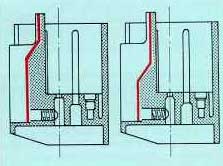|
|
| ducatimeccanica.com - home |
|
3.7 Acceleration
Every time the throttle is opened suddenly, the air speed in the barrel drops. In two-stroke engines this does not upset good engine running, but in four-stroke engines this drop in air speed causes the atomiser to deliver insufficient fuel. For this reason, on large-diameter Carburetor s for four-stroke engines, an accelerator pump enrichment device is fitted. 3.7.1 Diaphragm accelerator pump 
fig. 27 As shown in figure 27, on opening the throttle slide (9), lever (8) controlled by a special cam (7) cast into the front of of the throttle slide, acts directly on the pump diaphragm ( 1), I held out by the spring (2). 3.7.2 Selection of correct pump jet and slide pump cam  fig. 28 (left) fig. 29 (right)
fig. 28 (left) fig. 29 (right)
The size of pump jet selected determines the duration of fuel delivery, so the larger the pump jet used the shorter the pump spraying interval and vice versa. The quantity of fuel sprayed out has already been fixed. Pump jet selection must be effected with the engine running with rapid full-throttle acceleration; under these circumstances the optimum jet size should allow the engine to pick up regularly and promptly, rapidly increasing engine speed in every acceleration-speed range. 3.7.3 - Piston-type accelerator pump  fig. 30
fig. 30
|
||
| B A C K |
|
N E X T |